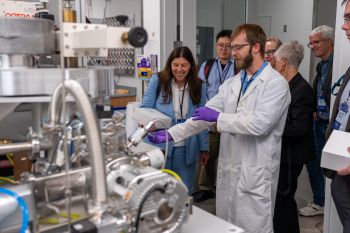University news
Sussex University celebrates 40 years of Nobel Prize-winning discovery that revolutionised chemistry
Posted on behalf of: University of Sussex
Last updated: Wednesday, 15 October 2025

It is now 40 years since one of the most important scientific discoveries of the 20th century - the identification of C60, or Buckminsterfullerene - by Sussex’s Professor Sir Harry Kroto FRS.
To honour the late Sir Harry’s legacy, Sussex professors Hazel Cox and Paul Nightingale and Sussex Alumnus and visiting fellow Dr. Jonathan Hare were invited to participate in a special anniversary event hosted by Rice University in Houston, Texas, on 13-14 October. The celebration brought together leading academics and policymakers from around the world to reflect on the discovery’s impact and continuing influence across chemistry, nanotechnology, and materials science.
While working at the University of Sussex in 1985, Sir Harry travelled to Rice University to collaborate with Professors Robert Curl and Richard Smalley, then both at Rice. Their experiments investigating carbon chains led to the discovery of a new form of carbon - C60 - a molecule composed of 60 carbon atoms arranged in a football-like structure.
Known as Buckminsterfullerene or the ‘buckyball’ - due to its resemblance to the ‘geodesic domes’ popularised by architect Richard Buckminster Fuller - this remarkable form of pure carbon was unlike anything previously seen, combining pentagons and hexagons in a stable molecular structure. Until then, pure carbon was thought to exist only as diamond or graphite.
The discovery revolutionised chemistry and materials science, earning the three scientists the 1996 Nobel Prize in Chemistry. It continues to inspire advances in nanotechnology, medicine, and sustainable energy - fields where fullerenes’ (carbon atoms) unique properties have opened new possibilities from hydrogen storage and solar energy to drug delivery and antioxidant therapies.
Professor Hazel Cox, University of Sussex said: “It was a real honour to represent the University of Sussex at an event celebrating such a remarkable scientific achievement. Professor Sir Harry Kroto’s discovery embodies the spirit of curiosity and collaboration that defines Sussex. His work continues to inspire our research today, pushing boundaries and transforming how we understand the world around us.”
The celebrations will continue into next year, marking 30 years since Sir Harry Kroto and his fellow scientists received the Nobel Prize in Chemistry, with an event at the University of Sussex on 6 October 2026 to further honour Sir Harry’s legacy and the enduring impact of his discovery.
Professor Sasha Roseneil, Vice-Chancellor and President of the University of Sussex, said: “Professor Sir Harry Kroto’s legacy shines at the intersection of curiosity and creativity. He showed the world that science is the rigorous pursuit of knowledge driven by imagination, and that its greatest feats are realised through international collaboration. His discovery, with colleagues from Rice University, of buckminsterfullerene reshaped the discipline of chemistry, whilst the passion he exuded for his research throughout his career at Sussex inspired generations of chemists.
“His legacy lives on across the world in the research and innovation that followed the discovery of C60, and right here at Sussex, in how chemistry is taught, understood and practiced on our campus.”
Rice University's Smalley-Curl Institute Director Junichiro Kono said: "The discovery of C60 redefined our understanding of carbon and launched a global era of nanoscience. We're proud to celebrate this shared legacy of collaboration between Rice and Sussex, which continues to inspire discovery 40 years later."
The University of Sussex has also produced a short film to celebrate this pioneering anniversary: